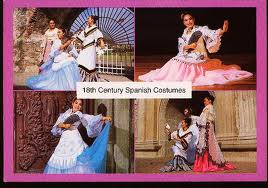HISTORY AND ORIGIN OF FILIPINO DANCE
by Guillermo Gómez Rivera, Bayanihan Dance Company Consultant-Resource Person, Balroom and Flamenco Dance Master and a former University Professor with a Ph D in Spanish and Literatura Filipina.
How did dance originate and was institutionalized in Filipino society? To properly answer this question, we need to review the cultural and political history of the Filipino people and society as we know them today.
The first clue is to investigate from what language does the word ‘Filipino’ come from. And, as it is obvious, we will instantly say “Spanish”. Indeed, the word or name Filipino is Spanish because it was derived from the name of a Spanish king, Felipe Segundo or Philip the Second of the Spanish Casa de Austria. Felipe Segundo was, by his father half Flemish or half German, he being a Hapsburg that was born out of the marriage between Prince Felipe el Hermoso (the handsome) and Princess Juana de Castilla (Joan of Castille, the famous Spanish Queen who became crazy, or mad, because of love and jealousy.)
The archipelago we now know as ‘The Philippines’ is really Filipinas or Pilipinas because of Felipe Segundo de Hapsburgo. Upon the establishment of the Filipino State by Miguel López de Legaspi in June 24 1571 (also the founding of Manila as the Capital of the Filipino State under the Crown of Spain), the Pre-Hispanic Ethnic States of these Islands were incorporated into that newly founded Filipino State that is today the basis of what is Filipino.
What were those Pre-Hispanic Ethnic States? Nothing else that the Tagalog States with their own Chieftains, territory in southern Luzon and their own language, the Pampango State of Central Luzon, the Ilocano State of Northern Luzon, the Bicolano States with their own language varieties, the Visayan States with their own related languages and the Mindanao Ethnic Lumads as well as the two Semi-Muslimized Sultanates of Maguindanao and Sulú or Joló with their own languages and little economy and trade.
In a synod-referendum held between 1598 and 1599, all the Chieftains of these Pre-Hispanic Ethnic States were ferried to Manila and asked by the Spanish authorities and friar missionaries if they accepted the King of Spain, Felipe Segundo, as their “natural sovereign” amid promises of enriching the land with new plants, new farming and agricultural technology as well as new products, an international galleon trade and new animals of burden like the horse, the cow and the carabao and a Religion that will take them to heaven after death.
After the majority of the Ethnic States, including some cordillera tribes and the Muslimized Sultanates, agreed to accept the Spanish King as their “natural sovereign” thereby enlisting themselves as part and parcel of the newly-formed FILIPINO STATE, a show of ethnic dances was instantly organized to the amazement of the Spanish conquistadores and friars. Each Pre-Hispanic Ethnic State displayed their respective dances to celebrate their unity under the newly formed Filipino State under the Crown of Spain.
The Spanish conquistadores and friars immediately noticed that, save some chants, all the dance movements were executed a to rhythm that had no melody. Drums, gongs, bamboo sticks, grass leaves, claps, cymbals were the instruments that provided the rhythm to the unchoreographed dances that also displayed what the Ethnic States had for their respective dress to cover their bodies. Though primitive, the dancers as well as the dances had their innate charm that entertained even the most discriminating of Spanish friars and conquistadores.
Based on that established unity, the Spanish government and church with their missionary labor included the introduction of music, the seguidilla chord that is now the basis of the Filipino melody in kundimans, habaneras and balitaos aside from the early church music as now discovered and revived in Bohol.
With the introduction of the town Fiesta culture, both Filipino Folkdance and Ballroom dance were born in all our old grand houses, mga bahay na bato, and municipal plazas and conventos. These Filipino dances, which show no trace of the newer American influence in this genre, has been with our people through the centuries and they are now priced as purely Filipino dance traditions.
A mirror of both the Pre-Hispanic and Hispanic dances can be appreciated today in the repertoires of local dance groups like the Bayanihan and the old Filipinescas.
More researches into Filipino culture and history is now yielding the direct links of Filipino folk and ballroom dances with the old Flamenco dances that flowered inside Intramruos de Manila and in many of the provincial cabeceras scattered all over the Philippine Islands.
Thus, the Filipino dance genre, in both its folkdance form, as well as in its socialized forms like the Rigodón de Honor, as well as its ballroom dances in the form of Habaneras, Pasacalles, Polkas, Valses, Pasodobles, Chotis, Danzas, Rumbas and Tangos, are well defined dance traditions that continue to give enjoyment to the new generation of Filipinos who naturally want to be proud of what we all know is Filipino culture Ang Kultura or La Cultura Filipina.
Posted by FILHISPÁNICO at 9:12 AM
Labels: FELIPE EL HERMOSO, HABANERAS KUNDIMAN, RIGODON DE HONOR
Sources:

well its so beautiful……wow
beautiful…
beautiful
nice one po………..